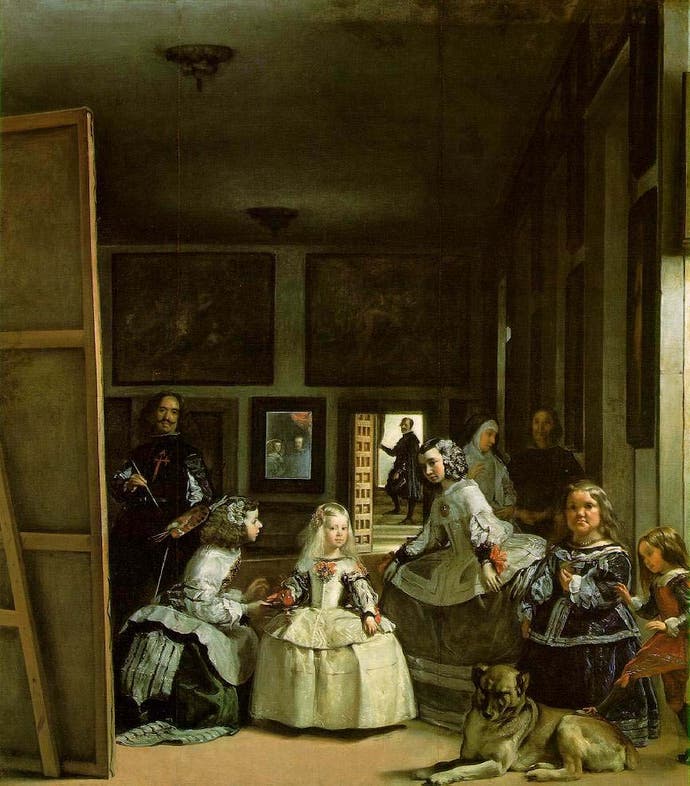Velazquez and the strange potential of VR
Portrait of a whale.
If you go to the Museo Del Prado in Madrid, you can look at a painting that seems to know you are there. It's called Las Meninas, or The Maids of Honour, and it's the greatest masterpiece produced by Diego Velazquez, a 17th century artist who only really seemed to deal in masterpieces.
I've just finished reading The Vanishing Man, by Laura Cumming, an absolutely brilliant book that makes the case for Velazquez in general and Las Meninas in particular. I'm left with the feeling that it might be the most thrilling work of art I've ever seen. Cumming's reading of Las Meninas is electrifying, presenting this huge canvas depicting a young princess and her attendants, as a profound exploration of the relationship between the people in paintings and the people who come to look at them.
"You are here, you have appeared," writes Cumming. "This is the split-second revelation in their eyes, all these people looking back at you from their side of the room.The princess in her shimmering dress, the maids in their ribbons and bows, the tiny page and the tall, dark painter, the nun whose murmur is just fading away and the chamberlain silhouetted in the glowing doorway at the back: everyone registers your presence... Now you have entered the room - their room, not the real one around you... You have walked into their world and become suddenly as present to them as they are to you."

People have studied Las Meninas for years to understand just how Velazquez managed to get this sense of interplay into his painting. Some have tried to recreate the room in 3D to unravel its secrets. Others have researched the lives of the people in the painting, including Velazquez himself, who peers out from behind a vast canvas - presumably the same canvas you are looking at when you look at Las Meninas. In truth, though, Las Meninas is a vibrantly sharp expression of something that Velazquez had already been interested in for years, something he was exploring when he painted portraits of the people who worked alongside him at the court of King Philip IV in Spain, and as he travelled - on the rare occasions he was allowed to travel - to Italy.
All of Velazquez's portraits are a little bit magical, in other words, and I don't mean that in the flim-flam way that - hey! - pretty paintings can be just magic! I mean it in the way they confront the audience with the person on the canvas so completely that you can't help but suspect the person on the canvas is aware of you, too. Velazquez brings his portraits to life, in the hoary old phrase, and Cumming brings portraiture in general to life in her book. And it's made me think. No portraiture in games. None of that stillness, that sense of a shared space, none of the intimacy and communion across time and space that occurs, so easily, when you stare into the eyes of Velazquez' Portrait of a Man (possibly Nieto), say, or Juan de Pareja. (The latter is a slave and studio assistant of Velazquez, and a gifted artist in his own right, who would eventually be granted his freedom by the painter; the former is a fellow courtier, who actually appears at the back in Las Meninas, too.)
Normally, I promise you, I hate this kind of thought: there are hundreds of thousands of things that games can do, so why should it matter about the things that they can't? Why should we want games to chase after other forms of art in the first place? The only thing about all that, though, is that the same week I read Cumming's book on Velazquez, I played around with the HTC Vive for the first time. I came face to face with a huge blue whale, and I felt - what? I felt a little of what I feel while looking at a Velazquez.
I have been in digital spaces in digital games before, of course. I have seen digital animals in the digital wild. And yet there was something different about the whale when viewed through the headset. Something about the circumstances. I suddenly realised how big it was, for example, which seems like a stupid thought but actually felt quite profound, because I didn't have to prod the camera so much as move my head around to take it in. And while doing so, I got not just its size, but a sense of the space it was filling, reaching far beyond me in every direction.
There was also something else: I was alone with the whale, cut off from everyone else, in an area the size of a small box room. When I caught the whale's eye, I felt like we were observing each other across a very real patch of ground, in other words, and I also knew that this is pretty much what this Vive demo is about: you look around, you see the whale, and then the credits run. This wasn't just a game in which you hung out with a whale - it was a game in which you only hung out with a whale. It was laying everything on for just a single effect.
Now that it's clear that people are going to make a serious stab at VR, in other words, the question arises of what kind of experiences are going to make sense with the tech. What will be the Tetris of VR? I haven't a clue, of course, and I'm very happy to leave this kind of thinking to the people who go to GDC each year. But if I was initially struck by the apparent limitations of the form after seeing the whale demo - I really don't think I'm going to want to play Uncharted or Skyrim on VR, personally - I'm now starting to get an insight into the strange potential it may have unlocked at the same time. Games in which you meet people. Games in which you get a sense of spaces and of characters. Games in which you are an observer as well as a more traditional participant. Games about coming to understand things. Where could this sort of thing lead?
It's fitting, I suppose, that if you really want to appreciate Las Meninas, you should go to the Museo Del Prado, where it towers above you, and where the people in the gallery seem to form part of the scene that Velazquez is orchestrating. I remember the best thing I ever saw Kinect do - and that was in a gallery, too: a dark, church-like room at the Barbican in which you stood before the camera and it projected shadows of you on the bright white wall behind you, in which it attacked you with birds, let them pull you apart, and then gave you wings to fly. I get a sense of that from VR, too - that it is peculiarly suited to life in a gallery, not least because the kinds of things I currently think I want to play about with in VR feel like installations, and also because I don't know how you monetise highly-polished five minute encounters, and make them pay for their own creation.
All of which means I really don't understand VR yet, I guess. At GDC there seems to be a real hedging of the bets. Is VR about hectic, breathless, exhausting arcade experiences, or is it a place that you can port old ideas into? Platformers, shooters, dog-fighting combat games? Is it both? Is it more? Regardless, this stuff is new - new in a way that Velazquez's paintings were new. And if we get anything even an iota as good as Las Meninas out of it, I'll be pretty happy.


